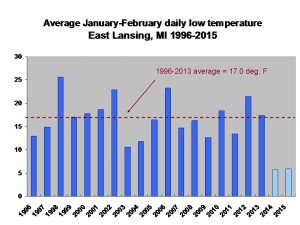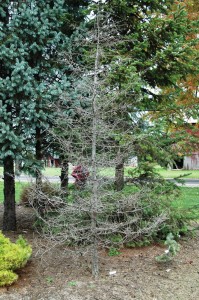I’m not sure we’ve ever been quite so ready for the calendar to turn to March. That’s assuming, of course, you live somewhere east of the Rockies. For people on the west coast, the sentiment is probably, “When are those people back East ever going to quit b-tching about their weather…” While I was dealing with 10” of snow and 25 mph winds whipping up 3’ deep drifts on Super Bowl Sunday, my friends back home in Washington state were mowing their grass. At this point I don’t even remember what my lawn looks like.
I have to confess that I thought winter 2014 was an anomaly and that we wouldn’t see weather that cold again any time soon, if ever. Boy, did I get wrong number. While winter 2015 is not exactly a carbon copy of 2014, I’m not sure most of us can tell the difference. In case dealing with sub-zero wind-chills for weeks on end wasn’t torture enough, I dug into the weather records from our automated Michigan EnviroWeather network to see how the past couple of months stacked up. To keep things simple I queried the records for the past twenty Januaries and Februaries. I just include those months since we don’t have any data for this March yet and those are the months we typically get our coldest weather, though we occasionally also get sub-zero in late December.
Over the last 20 years the past two winters have been by far the coldest, and it’s not even close. Over the previous 18 years the average daily low temperature for January and February was 17.0 deg. F. In 2014 the average low was 5.9 deg. F; this year it was 5.8 deg. F.

Not only was it colder on average but we’ve had more extreme cold events in the past two years as well. Between 1996 and 2013 we averaged less than one day per year with low temperatures below -10 deg. We were below -10 deg. F on eight days this winter and nine days last winter. The bottom end of our USDA Hardiness Zone 5 is -15 deg. F. We have been below that mark five times this winter, compared to twice last year and zero times in the previous 18 years.

Obviously this data is specific to mid-Michigan, but I suspect most locations in the Midwest and Northeast will have similar stories to tell. So what does all this mean? For one, our hardiness zones are what they are for a reason. Folks that like to ‘push their zones’ (you know who you are), have gotten away with it with impunity for nearly 20 years. This winter and last were time to pay the piper. 
The other take home lesson is that climate doesn’t consistently move in one direction. Even if we’re in a period of general warming, extreme events will still occur. This is important to remember as we think about planning for projected future climates. We have seen the appearance of several climate-change friendly plants lists. In some cases the authors have simply looked at projected climate zones and moved plant selections northward. The problem with this approach is tree survival is based on extremes, not on averages.
It seems like many places are dealing with yo-yo like weather. I know here on the prairies we have noticed weather has changed from dry to wet since about 2007/8, as the Pacific Decadal Oscillation (PDO) flipped over to the cool cycle. I wonder if the PDO also influences your region or some other cyclical system?
After last winter, I decided to migrate along with the birds – boy, am I glad I did!